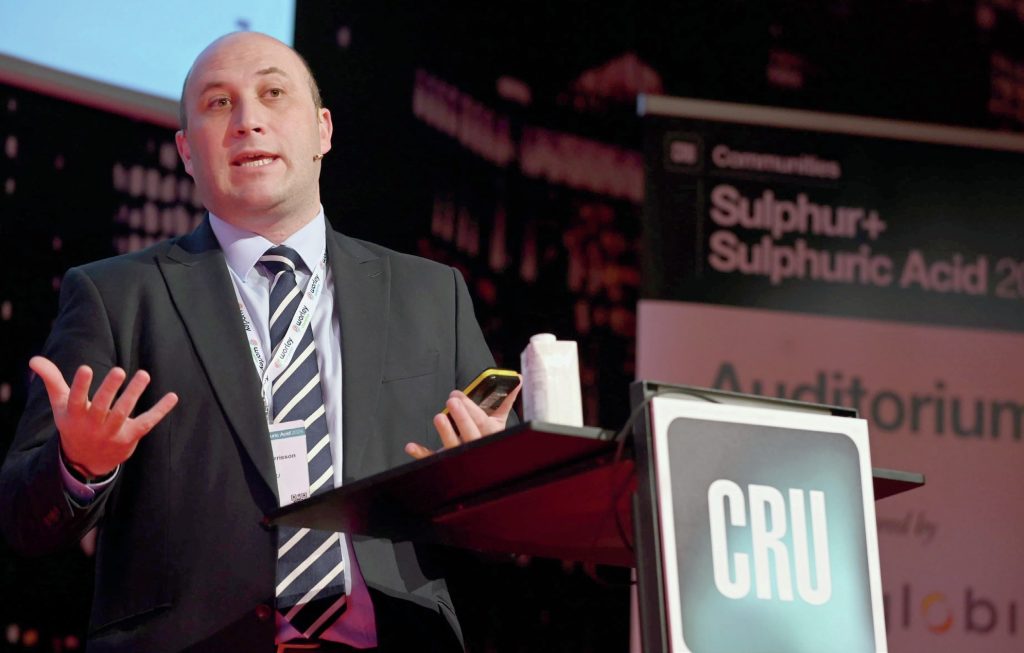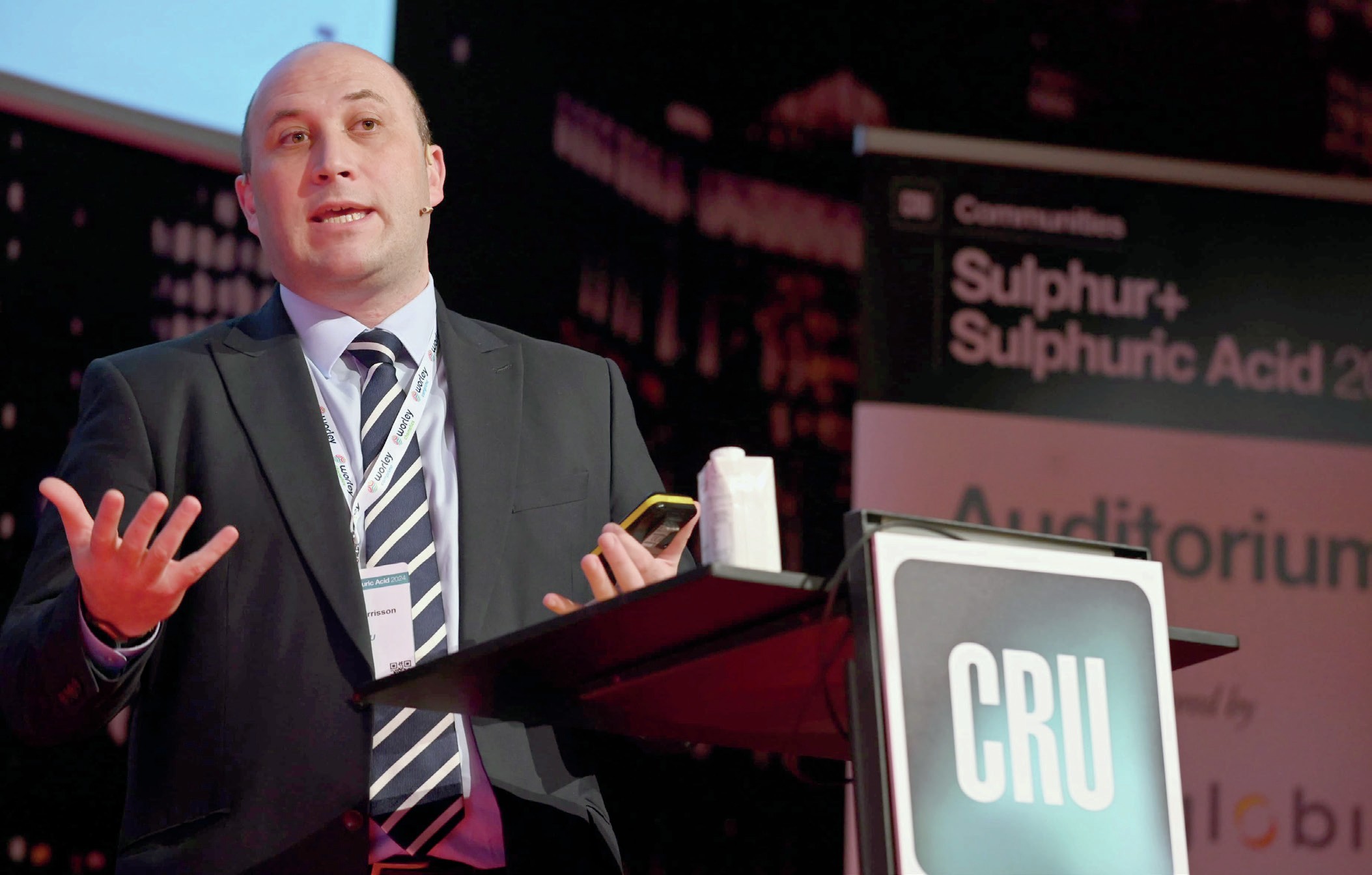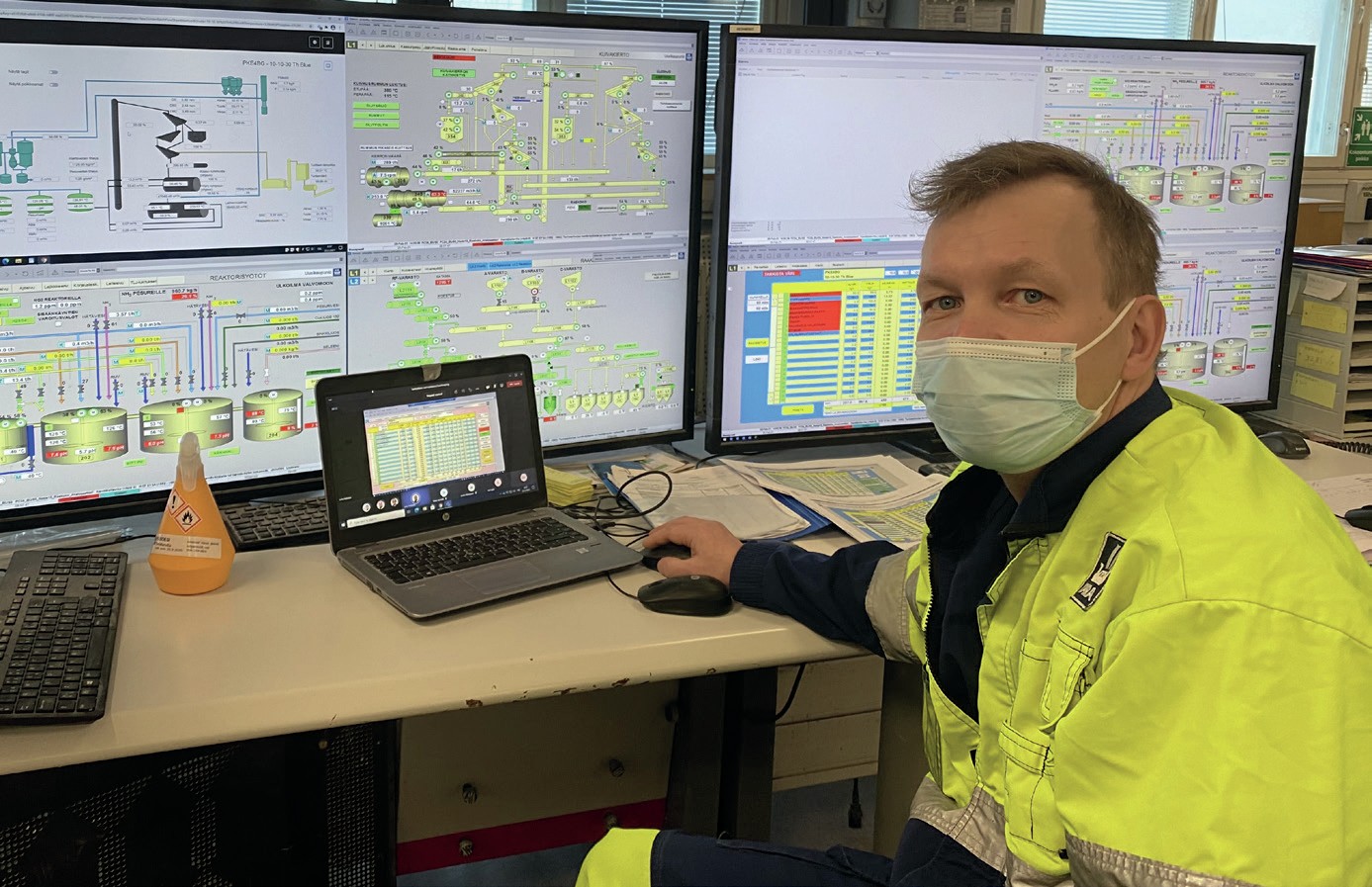Sulphur 415 Nov-Dec 2024

30 November 2024
Sulphur+Sulphuric Acid 2024
CONFERENCE REVIEW
Sulphur+Sulphuric Acid 2024
A report on CRU’s annual Sulphur+Sulphuric Acid Conference, held in Barcelona, in early November.


CRU’s 40th Sulphur+Sulphuric Acid Conference and Exhibition was held at the start of November this year, marking the first time that it has been run with Sulphur magazine back under the CRU banner. It was appropriate then that the welcome address was given by Sulphur’s managing editor Lisa Connock, who remarked that this year has seen strong attendance, with more than 450 delegates representing over 200 companies from 43 countries.
Commercial session
The conference proper was preceded as usual by a morning of short Technical Showcase presentations by, amongst others, Wood Group, WIKA. Thermetrics, Howden Turbo, Wylton Chemical, Ohio Lumex, Düchting Pumpen Maschinenfabrik, and Academia Holtec, as well as two troubleshooting clinics, one on sulphur and the other on sulphuric acid.
The commercial session began with a keynote speech by Christian Sattler, director of the Institute of Fuels in Germany. His talk concerned sulphur’s role in renewable energy pathways, and touched on the hybrid sulphur cycle, which can help convert water using high temperature heat, for example from a nuclear reactor, into hydrogen, reducing the mount of electrochemical energy required for electrolysis by 66% compared to cold electrolysis. He also mentioned SO2 depolarised electrolysis, and sulphur based thermochemical cycles which could use sulphur as an energy carrier, using a sulphur splitting reactor – there was more detail on these in the institute’s technical paper (see Sulphuric Acid Technology, below).
This was followed by a panel discussion on sulphur and sulphuric acid in the energy transition, chaired by Hannes Storch of Metso and also including Khalid Hamed Al-Ahmadi of Ma’aden, Lucretia Loescher of thyssenkrupp Uhde, Sascha Vukojevic of BASF, Graham Cousland from Begg Cousland Envirotec, and Francesca Ortolan from Cefic. BASF have reduced their CO2 footprint by 60% since 1990 and want to reduce this by another 25% by 2030. The biggest source of emissions is power and steam production, and so they are shifting to making renewable electricity at sites globally. Lucretia Loeschler said that green molecules are three times more expensive than grey, so without guaranteed offtakers the economics do not work, and regulations are also important.
Sulphur markets
CRU’s Dr Peter Harrison as usual gave the market overview. Sulphur prices have swung in 2024 from bust to boom. Having started 2024 relatively depressed at $70/t, but the past 2-3 months have seen prices take off. Sulphur has been undervalued relative to phosphates, but affordability has weakened as the sulphur price increases. New Middle Eastern supply is driving a surge in exports by 1.5 million t/a, but Chinese imports have risen by 800,000 t/a to 9.7 million t/a this year, and imports to Morocco and Brazil are also up. There have been stock drawdowns in Arabia and Kazakhstan which have masked relative undersupply this year, though a stock accumulation of 1 million t/a has happened in China.
On the demand side, metals markets are contributing to demand growth, with 3.2 million t/a of extra demand by 2029, mainly in southeast Asia, alongside 6.7 million t/a of demand from fertilizers, much of it in Morocco as well as Saudi Arabia and the US, and 1.7 million t/a from industrial uses. Supply growth is slow to 2027, when a new wave of capacity will hit with several large new projects coming on stream. Europe is seeing supply slow as refineries close or switch to bio-feeds, and by 2028 Europe will be a net sulphur importer. There is some substitution with acid replacing sulphur, but the continent may need more remelters. The US sulphur deficit is also widening as demand grows for lithium and phosphates and again falling output from refineries, with the US becoming a net importer from 2025, and imports increasing to 2 million t/a by 2029. In Central Asia, Kazakhstan has seen 1.2 million t/a of stock drawdowns in 2024 and probably another 600,000 t/a in 2025, but after that the stocks will be gone and the market will need to find a balancing factor from elsewhere. Middle East is driving supply availability, with Ghasha adding 3.4 million t/a, Shah 1 million t/a and Al Zour 1 million t/a of sulphur capacity. China is seeing imports fall as domestic supply increases – by 3.5 million t/a to 2028, while Indonesia is pulling in ever increasing imports. Overall, the market will be in deficit for the next couple of years, with higher prices, but will move back into balance by 2028.
The presentation was followed by another panel discussion, on economics, strategy production etc, led by Peter Harrison and including Viviana Alvarado of CRU, Craig Jorgenson of TSI and Janne Loven of Boliden. Craig Jorgenson noted that the new lithium projects in Nevada – Lithium Americas at Thacker Pass and Ioneer at Rhyolite Ridge – will rely on sulphur burning to generate acid for their activities and may find sourcing sufficient sulphur a logistical challenge, especially given refinery closures in California and conversions to biofuel plants, reducing supply there by 400,000 t/a.
Sulphur technology
Lower carbon options are of course very much in vogue at the moment and several papers in the sulphur technology section looked at ways of reducing carbon footprint from a Claus reactor. H2 S is a potential source of hydrogen, and ITT examined ways of arranging an SRU to have an H2 S-splitting side stream to generate H2 . It can even use electrical heating using renewable energy for a carbon negative process. Worley Comprimo examined options for saving energy in a Claus reactor using lower reactor inlet temperatures, reduced co-firing and lower temperatures in the incinerator. Topsoe argued that a wet sulphuric acid (WSA) plant as an alternative to an SRU lowers carbon footprint considerably. IOCL’s refinery at Haldia in India has recently made such a change.
Digitisation
As digitisation continues to make its way into sulphur plant operation, Worley Comprimo presented an analysis of factors to consider in developing a new 300 t/d sulphur facility in Europe using the probabilistic computer modelling features of their Indicatura software to determine life cycle cost and net present value, as well as factoring in CO2 equivalent cost. The conclusion was that TOPCLAUS® is the most prominent technology in terms of revenue, but it also offers the highest potential for CO2 emissions saving, while EUROCLAUS® (and SUPERCLAUS® + CSU for more stringent legislations) have the best results from the most conventional technologies.
Maire NextChem looked at digital process modelling to improve the efficiency of SRU operation, and Voovio Technologies examined enhanced reality technology for operator control systems to reduce human error and increase operator competence.
SRU operation
The SRU operations papers began with a design presentation by Bechtel which described best practice in designing SRUs, including strippers and tail gas treatment units.
Drawing on their experience of dealing with operator issues, Sulphur Experts said that optimising incinerator operation remains the best way of not only improving SRU operation but also making savings in fuel gas consumption and CO2 emissions. Ben Spooner of Amine Experts meanwhile looked at preventing amine carryover from amine regenerators, using anti-foamers and foam testing of rich amine solutions.
Wood looked at considerations for reliability, safety, and operations responsibilities during extended downtime, and how best to look after a Claus plant that is expecting a prolonged period of being idled, while Rob Marriott of ASRL presented the results of a study into the presence of ammonia in SRUs with alkanoamines as a potential source. The study found that tertiary (MDEA) and secondary (DEA and DIPA) amines were more difficult to convert to NH3 compared to primary amines (MEA and DGA). Through gradual accumulation, it is feasible that alkanolamine introduction to the Claus thermal reactor could lead to a buildup of ammonium salts.
AMETEK meanwhile looked at ways of measuring BTEX in process gas feeds to ensure complete destruction in the SRU (see article page 36).
Operator case studies
ADNOC Sour Gas described some of the issues experienced with their ground breaking Shah sour gas plant, including water carryover issues and challenges with steam quality in the waste heat boiler, corrosion in reheaters and the degassing contactor, and efficiency and emissions challenges with the incinerator. Kuwait Oil Co addressed sulphur-induced iron sulphide formation in effluent water treatment and injection facilities, examining both chemical and non-chemical ways of tackling the issue.
Sulphur handling
David Savage of Matrix PDM described Matrix’s approach to safety in design for sulphur forming and handling facilities, particularly mitigation of the highest risk factor – airborne sulphur dust – via suitable levels of moisture content in the sulphur.
Marcus Weber of Fluor, meanwhile, looked at scaling up sulphur degassing systems to large scale sulphur recovery plants. Fluor’s D’GAAS system can eliminate the need for a sulphur pit and its associated problems, and can be modularised for relatively easy scale up (see article page 40).
Finally, Sulphurnet noted that there is increasing sulphur coming from remelting of block and other long term storage at present, and examined some of the potential contamination issues and the challenges they could pose for SRU operation.
Sulphuric acid technology
Burning sulphur is a carbon free source of energy, and so perhaps unsurprisingly sulphur burning acid plants have become the focus of a lot of thinking on the energy transition, circular economy and the like. The sulphuric acid technology session began with presentations looking at decarbonisation and energy efficiency, including the work of the Deutsches Zentrum fur Luft und Raumfahrt and Grillo Chemicals (German Aerospace Centre – DLR) on using sulphur and sulphuric acid in decarbonisation. DLR is working on several pathways, including SO2 depolarised electrolysis, which uses the SO2 produced during sulphuric acid decomposition to produce hydrogen as well as fresh sulphuric acid as an additional product, and hence can be used for spent acid recycling while generating hydrogen at only 14% of the energy cost of PEM electrolysis. Another project uses mirrors to concentrate sunlight and convert it into high-temperature heat energy which can then be used to split sulphuric acid. The resulting fission products sulphur dioxide (SO2 ) and water (H2 O) are the starting products for producing fresh sulphur – the latter can be stored or burnt in a gas turbine to generate electricity. This in turn produces sulphur dioxide (SO2 ) as a fuel gas, which is fed into conventional sulphuric acid plants. This produces fresh sulphuric acid and a large amount of waste heat. The waste heat drives a steam turbine, which generates additional electricity. The fresh sulphuric acid is then available again for the splitting of sulphuric acid.
Nelson Clark of Clark Solutions looked at increasing heat recovery from acid plants by using a waste heat boiler instead of an acid cooler. Acid and water streams are kept separate in the SAFEHX heat exchanger to avoid issues with leaks using an inert and water/acid immiscible heat transfer fluid between the two sets of tube bundles. Boiler feed water can also be routed through the exchanger to remove the need for a pre-heater. In this way a double absorption plant can increase heat recovery from 70% to 90%, and higher still (95%) for a single absorption plant.
Other uses discussed for heat from acid plants included Aurubis and SmartSCOPE using waste heat from the Aurubis Hamburg smelter acid plant for district heating locally, while KVT Technology described using Oxysulf wet sulphuric acid technology to utilise sulphurous off-gases from a pulp and paper based bio-refinery, treat off-gases and generate additional heat and acid for the rest of the plant.

Catalysts and emissions
Catalysts are at the heart of any sulphuric acid plant, and Anders Madsen and Martin Alvarez of Topsoe delivered a comprehensive look at the relationship between catalyst size, shape, activity, pressure drop and mechanical strength. Jochen Willersinn of BASF presented his company’s O4-116 Quattro quadrilobe acid catalyst, with increased vanadium content and potassium and caesium promoters as well as an increased pore size, designed to maximise SO2 conversion and minimise SO2 emissions from the plant. Johannes Hofer of P&P Industries meanwhile showcased their platinum promoted honeycomb catalyst VividOx, which can convert high SO2 streams (up to 35%) in one reactor with over 95% conversion.
Acid plant design
Colin Bartlett presented Metso’s paper on using oxygen enriched air to boost acid plant capacity in the Lurgi Recirculation process (LUREC). Although it has had operating references for more than a decade in China, Colin noted the conservatism of the industry in the uptake of new technology, remarking: “nobody wants to be first in this industry – everybody wants to be fifth.”
Carolina Sanchez of Worley Chemetics went through the use of the CORE tubular reactor in flue gas desulphurisation – CORE-FGD – when there is a variable concentration of SO2 in the gas stream. The system has recently been installed at a sour gas processing facility for Pertamina in Indonesia producing 192 million scf/d of sales gas. Using a regenerative scrubber to concentrate the SO2 an acid plant capacity of 377 t/d has been achieved with a turndown capability of 20-100% of maximum. Acid production has actually been lower than expected due to lower sulphur content in the feed gas, though this illustrates the turndown capability of the process.
Mark Ferra of REXA described the importance of control systems actuators – actuators control when and how control valves are used and hence better control of the actuation leads to better control of the process and better results. REXA produce an electric motor with hydraulic transmission which costs more than a conventional pneumatic system but with much lower maintenance and precision that gives it a short payback period.
Daniel Ficklinger of Hugo Petersen examined the co-production of liquid SO2 with sulphuric acid via condensation. The process can handle dynamic plant loads for variable production of acid vs SO2 , and is able to reuse process heat in the waste heat boiler and economiser.
Finally, on the literal nuts and bolts of plant design, NORAM took delegates through designs for ducting and expansion joints to accommodate combinations of thermal expansion and vertical movement.
Acid plant operation
Improvements in acid plant operation were shared by Steffen Haus of Metso, who presented some case studies of how digitisation of plant operations is increasing the efficiency of plant operation, and Combustion Solutions, who described a revamp of an acid plant using advanced burners and flow techniques to boost output from 2,200 t/d to 3,000 t/d. There was also operator input from Ayman Abd El Hafeiz of Abu Zaabal Fertilizer and Chemical in Egypt on improvements to their Plant no. 7 which had boosted the stability and reliability of operation, and Petrokimia Gresik, who had to make emergency repairs to a damaged stainless steel trough-type acid distributor during a recent shutdown.




